QNAP TS-453mini NAS Review
Qnap takes a vertical approach to reduce noise, and making for a small office NAS that fits in tighter spaces.
Why you can trust Tom's Hardware
Software
Features
Early in the setup process, QNAP SMB systems ask if the system will be used in a business or home. Your answer dictates the initial system configuration and the applications installed. At any point, you can add business or home applications depending on your needs. I almost always choose business, because I don't use all of the applications for home users.
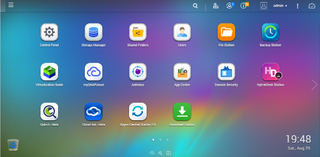
Over the last quarter, QNAP released QTS 4.2 Beta, our first look at the upcoming operating system GUI that sets the stage for years to come. QTS 4.2 isn't a radical departure from previous releases, but it does look and feel a little different.
QNAP's QTS software ships with several preinstalled features from the factory. The loaded QPKG packages, QNAP's version of an app for your NAS, are enough to get you started. The company has more than 160 additional QPKG apps available for free. Users can download the applications from the NAS operating system via a dedicated page. The software will automatically download the application and it install it without hassle. The apps offer a good mix of client software, the things you may use in your home and pure business applications. You can see the full list here.
QNAP's software also goes beyond the NAS. A number of mobile apps for iOS and Android allow users to take the content stored on the NAS on the road via an Internet connection. The transcoding feature in the TS-453mini plays an important role when streaming video to remote locations. The mobile applications support much more than just video. You can see the full list of mobile applications here.
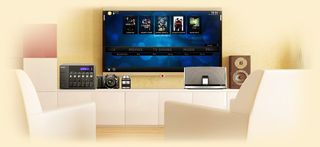
By bundling the TS-453mini with a remote control and designing the airflow to make an already quiet product line even quieter, QNAP set the stage for this NAS to become a real media-center powerhouse. On-the-fly transcoding allows users to move the media beyond the theater in other formats as well. Your media can stream to other media players in the house over Ethernet, or outside of the network to mobile devices.
Interface
In the future, we will add comprehensive feature stories showing NAS operating systems and GUIs. There are too many pages, too many features and too many add-on packages to introduce in a product review.
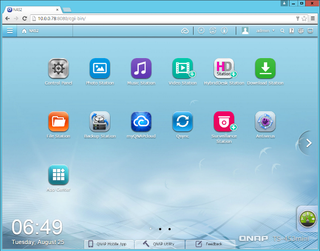
There are hundreds of pages in the QNAP QTS operating system, but they all start here on the main page. The icons are similar to your Android phone icons; you can move and position them. There are three pages, so you can organize them by pages if you like. Users can also add or remove icons as needed.
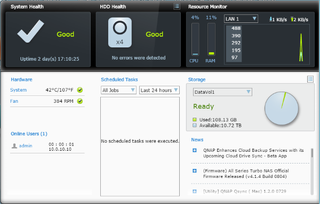
A health-check feature on the lower right corner of the dashboard opens up to what we see here. The monitor provides a quick way to catch the latest QNAP software news, see details about firmware updates and view the status of your system. You can see the status of your array and CPU, and memory usage and network-traffic activity. There is also a pane that shows if other users are logged in to the system. This is useful in an office environment. You don't want to update the firmware and restart the system if a co-worker is using the system for a presentation at a remote location.
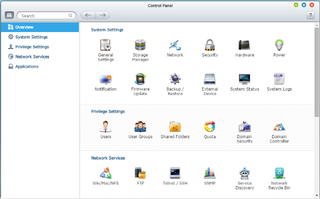
Before we even get into the applications, the system has a lot of user-accessible configuration features. Everything comes configured from the factory at usable settings. Users can easily configure options to suit their needs, providing a custom experience.
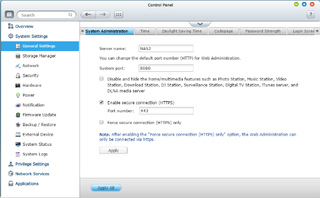
Users can elect to disable and hide all of the home/multimedia functions by clicking a single check box. This is a nice feature to save processing power and system memory if the features are not used.


In the Storage Manager area of the QNAP QTS OS, users can build arrays either in volumes or by pools of disks. Disk pools were introduced just a few years ago and allow the NAS appliance to tackle storage like an enterprise SAN. The same disk in the system can be part of two separate RAID arrays. For example, part of the drive may be part of a RAID 0 array, and another section of the disk may be part of a RAID 5 array.
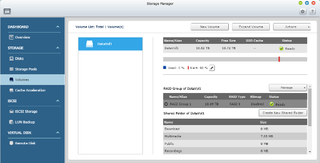
When we test QNAP NAS appliances, we use the single-volume option. Systems with seven drive bays and lower are tested in RAID 5, while systems with eight or more disks are tested in RAID 6.


Users have a lot of options for the network. QNAP enables several modes of network teaming including 802.11ad link aggregation. There are a few ways to connect to the system from outside of your intranet. The server is accessible from QNAP's cloud feature, a free service through a specialized website, or through a third-party DDNS service.
Stay on the Cutting Edge
Join the experts who read Tom's Hardware for the inside track on enthusiast PC tech news — and have for over 25 years. We'll send breaking news and in-depth reviews of CPUs, GPUs, AI, maker hardware and more straight to your inbox.
-
thebigt42 $140 just for 8 gig of ram vs 2. That is nuts! I bet they lock down the 2g version so you cant change the ram yourself too.Reply -
astonerii You keep changing the GB on these things. The 8GB is 4GB several times and the 2GB is 4GB at least once.Reply
Really too bad the prices are so high for these things, but they are niche items I guess. I would like to have one, but prices are too high for my want. -
Haravikk Every time a NAS ships with an external power brick of dubious origin I just can't fathom why; while a power brick is a bit easier to replace if it fails than an internal PSU, if they used a standard PC type (e.g- an SFX PSU) then it needn't be that hard. Better yet, a device in this size could easily stand to be a little taller if it meant it could accommodate a pair of slim PSUs such as those common in servers (for redundancy).Reply
Aside from often coming from an unknown source, and being easily the most commonly failing component (more so than hard-drives in my experience), power bricks just destroy any aesthetics that a company tries to put into their "small" devices; hint, if a device is only small because you've made components external, then it's not small, it's badly designed.
Sorry, but it's a real annoyance for me, and the reason I'd rather build a NAS in a small(-ish) PC case as I just don't trust power bricks at all, and for an always-on data storage device that's a pretty big negative. -
Uneventful I am would really like to know more about the Home Theater possibilities of this NAS. The article mentioned that it came with a remote, but that was all. I would like to know a couple of different things: What application or interface it uses if you hook it up to a TV via HDMI and use the remote? What sort of files can it play back? Does the HDMI 1.4a port support 4K?Reply
I have a older QNAP NAS myself and I know that it can run the Plex Server, but is the TS-453mini able to transcode fast enough with the hardware transcoding for watching 1080p on a client? Can you run it as a Plex server and have it playback on the TV at the same time? Does it have support for outputting DTS or DD streams? I would really like more details about how this NAS could be used in a home theater. -
CRamseyer I'm working on a software overview article for each of the major NAS companies right now. There is a lot to go over for each.Reply
The two most common for home theater use are XBMC and KODI. KODI is just the newer version of XBMC. The software supports 7.1, DTS, Dolby, the HD versions and so on. I use KODI to play back 1:1 Blu-Ray ISOs and it works great.
The system can run Plex Server and it's fast enough to transcode on the fly. -
jakjawagon Reply$140 just for 8 gig of ram vs 2. That is nuts! I bet they lock down the 2g version so you cant change the ram yourself too.
Actually they don't. While they recommend you only upgrade using the overpriced kit they'll sell you, it is compatible with standard laptop DDR3 RAM and easily upgradeable.
I bought a TS-451 a few months ago (pretty much the same specs but half the RAM and a CPU with fewer but higher clocked cores, and a more traditional design), and am mainly using it as a media server. Apart from one squeaky drive (salvaged from an old laptop and due to be replaced when I can afford it), I'm very happy with it. Fast enough for my needs, and very configurable even though default settings work well. -
Dyason ReplyI'm working on a software overview article for each of the major NAS companies right now. There is a lot to go over for each.
The two most common for home theater use are XBMC and KODI. KODI is just the newer version of XBMC. The software supports 7.1, DTS, Dolby, the HD versions and so on. I use KODI to play back 1:1 Blu-Ray ISOs and it works great.
The system can run Plex Server and it's fast enough to transcode on the fly.
Fantastic to hear it runs Plex Server. Curious if it will run Plex Theatre for playback as I prefer this over XBMC and KODI. Does it just run normal linux apps for playback? -
CRamseyer https://www.qnap.com/i/en/app_center/Reply
The link goes to a list of applications that are already in the App Manager. Plex Theater is on the list. -
mwituni As an existing QNAP user, I don't know how any QNAP NAS's can be seriously considered for any awards, nor why they do so well on reviews They entice buyers with fancy options, but are not interested in developing applications users need.Reply
SVN (Subversion Source Control) is the most popular and source control software in use, yet QNAP have been promising a proper SVN-server application since 2009, and still not delivered! How can users take them seriously - they're obviously not interested in developing applications the community needs, only the minimum needed to trick buyers into purchasing and evaluators to award prizes. They claim you can install SVN by an outdated method - which is very risky and outdated by a few years, and in my experience does not work at all.
They have a GIT client, so can claim they "have" source control applications. But no SVN support.
Their marketing department needs to kick the development team into gear.
-
Rop Hi guys, i own a 453 Mini and it works great for my needs.Reply
Wish to know if anyone can explain in better detail about why there are so many reports on the Intel Celeron J1900 accesing more then the 8GB ram that are in the spec sheet for the procesor, as many haave installed 16GB and claim it to be fully accesable and usable. And has anyone actaully tested this to be 100% certain that i can in fact accesss more ram then Intel states?
Thanks in advance for you contribution.
